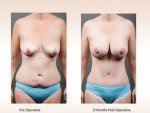
Some women with breast implants are being diagnosed with the rare form of lymphoma, breast implant-associated anaplastic large cell lymphoma (BIA-ALCL), and the spotlight on implants is shining brighter than ever before. BIA-ALCL is NOT breast cancer, and if detected and diagnosed early, it’s curable if treated properly. While the link between breast implants and cancer is definitely not going away, it is to be noted that one type of implant in particular seems to be causing the most concern. The women diagnosed have all had textured implants inserted and one Queensland doctor has had seven patients develop the disease.
Don’t Panic!
Before you start to panic about your implants causing BIA-ALCL, lets help you understand the ‘type’ of implant that seems to be causing the most concern. All the implants identified as being associated BIA-ALCL are textured and the vast majority (over 85%) of these are the macro textured implants.
There are different types of implants and different types of texturing of the implants. These are:-
- Macro-textured implants (e.g brand names “Allergan” & “PolyTech”)
- Micro-textured implants (e.g Mentor)
- Nano-textured implants (e.g Motiva)
- Smooth implants (most brands carry smooth implants in their range)
Ask Your Surgeon If They Have Used Macro-Textured Implants
If you’re worried and want to put your mind at ease, just ask your surgeon if they have used macro-textured implants. Over the next year or so it would seem that more brands are developing smaller textured implants (such as the nano implants which the Motiva brand have pioneered which were TGA approved in Australia earlier this year) and these will be introduced into the market to help with this as well. The shape of implants (round or anatomical) does not have any effect or come into play with BIA-ALCL.
Budget Breast Implant Surgery
It’s been rumoured that some clinics that offer or have been offering ‘budget’ breast augmentation surgery were only using the macro textured implants. Based on the current findings, anyone who has a macro textured implant is at a higher risk than anyone who has had micro, nano or smooth implants BUT we have to quantify this by saying that the risk irrespective is low. One in 3800 is still a lower risk compared to 1 in 8 for breast cancer.
Should You Be Worried, How Would You Know?
BIA-ALCL – how would you know? You would present with fluid in your breast capsule – and this could happen anywhere from 4 to 15 years after having the implants, and the average time is around 8 years. You may feel it, or you might feel there’s fluid in the breast, a change of volume or size of the breast that may not be associated with pain or a trauma event. Keep in mind that the vast majority of people will NOT have it anyway.
Your surgeon will investigate and exclude it for you by taking the fluid and checking it for the cells. So unless there’s a collection of fluid – there has to be a physical example of fluid – it makes no difference. You should go to your treating surgeon and the surgeon should arrange an ultrasound and see if there’s any fluid. If there is they can aspirate any fluid if need be. There’s no investigation or test that will tell you that. So the only way to know is if you presented with fluid in your breast, and it would have to be a large volume (ie about 50ml of fluid) that would have to be tested.
If you want implants and you want risk at 0 based on current research a smooth round implant is your option – any implant has a risk but the risk is different depending on the type of implant you get inserted.
Australia is leading when it comes to information about BIA – ALCL
The Sydney Morning Herald reported on the weekend that apparently more than 333 women worldwide with implants have developed the cancer and four of these women have died. There is what is called “clusters” of cancer being found in women with implants across Australia, however it is likely this has only been identified because of the Australian Breast Implant Registry, a new initiative run by Monash University that records which patient has what type of implant.
Additionally, the Australasian Society of Aesthetic Plastic Surgeons (ASAPS), Australian Society of Plastic Surgeons (ASPS) and New Zealand Association of Plastic Surgeons have collaborated to create a BIA-ALCL Joint Task Force to collate clinical data that is then shared with the TGA to ensure the public are provided with the most up to date information possible on breast implants. Dr Mark Magnusson, President of the Australasian Society of Aesthetic Plastic Surgeons and chairman of the task force, says, “Uniquely, what we have been able to achieve is to compare the number of cases with the number of implants sold for the first time. This has allowed us to perform a more accurate assessment of the risk but also for the first time define the different level of risk associated with different breast implants.”
It is only because of Australia’s excellent collaboration between different groups and organisations, our health system, and our reasonably small network of surgeons who insert and revise breast implants that we have such readily available data. Whilst other countries such as the US and the Netherlands are also on par with doing their own studies, Australia definitely holds it’s own when it comes to keeping patients informed. Not only that, but the Australian BIA-ALCL Task Force is communicating with colleagues around the world to ensure the information being gathered is as comprehensive as possible.
What is ALCL?
ALCL is a rare disease of the T-cells of the body (Immune cells). It may be caused in part by a reaction to bacteria that grows on the surface of the breast implant. Apparently, any implant will be inserted with at least some minute amount of bacteria, but a macro-textured implant has an uneven and hence larger surface area and subsequently the capability to hold more bacteria. There have apparently been no cases of ALCL in women who’ve had smooth implants inserted.
What are the Symptoms of ALCL?
Developing on average 3 to 14 years after the insertion of the implant but most commonly around 7 – 8 years, swelling of the breast caused by fluid (not a small amount, a larger amount – maybe around 100ml or so) around the implant is a common symptom, but it can also be a lump in the breast or armpit.
The TGA are reviewing the breast implants available across Australia in order to provide more information for women considering a breast augmentation with implants. Whilst Australia has one of the best safety ratings in the world when it comes to plastic surgery procedures, this issue is more about the type of implants used and not necessarily the skill or the experience of the surgeon performing the procedure.
However, it is definitely suggested that infection control standards are of utmost importance during breast implant surgery to minimise any risk. Another reason to choose your surgeon and clinic very carefully.
What Implants Should You Choose?
Some implants do have a higher risk of subjecting you to the risk of BIA-ALCL. You need to have that discussion with your surgeon to identify which implants they use, which are going to suit you and your needs better, and weigh up the relative risk and benefits. Your safety is not only up to your surgeon, it’s up to you too – choose wisely! If you are unsure, contact [email protected] and we will send you a link to surgeons near you.
You might also want to consider that there is another option for breast augmentation now with fat transfer as more patients come in to remove their implants and replace them with their own fat.
What if you already have implants?
Be aware of any changes in shape or feel to your breast implants and if you are at any time concerned see your doctor or surgeon and they can arrange the appropriate testing. Mammograms are not enough to identify if you have the disease. Unless you have any signs or symptoms, it is not recommended that you will require implant removal, or have any reason for concern.
Remember that ALCL is an extremely rare disease. It is important to be aware of any risks when it comes to any plastic surgery procedure, and this is just one of them. ALCL is curable when diagnosed early, and there have only been 12 deaths recorded worldwide from this disease, with millions of breast implants being inserted in women around the world for the last 50 years.
If you are concerned and have any questions, please email [email protected] with the subject line “BIA-ALCL CONCERNS” and an expert Plastic & Reconstructive Surgeon will respond.
Professor Anand Deva has come up with the 14 point plan which are proven strategies for surgeons to use when inserting breast implants. Check it out!
A big thank you to Sydney Plastic Surgeon Dr Rohit Kumar for helping me get all the information correct!
Further Reading Related to Breast Implant
- What Are the Most Natural Looking Breast Implants – Dr Watts Surgeon Perth
- History of Breast Implants and Breast Enlargement Surgery by Dr Carmen Munteanu
- Bra Cup Sizes related to Breast Implant Sizes – Dr Bish Soliman
- What Is the Right Implant Placement Option – Dr Michael Kernohan
- Types of Breast Implant Incisions by Dr Jake Lim
- Breast Implants Profile, Projection, Shape, Sizes and More






















